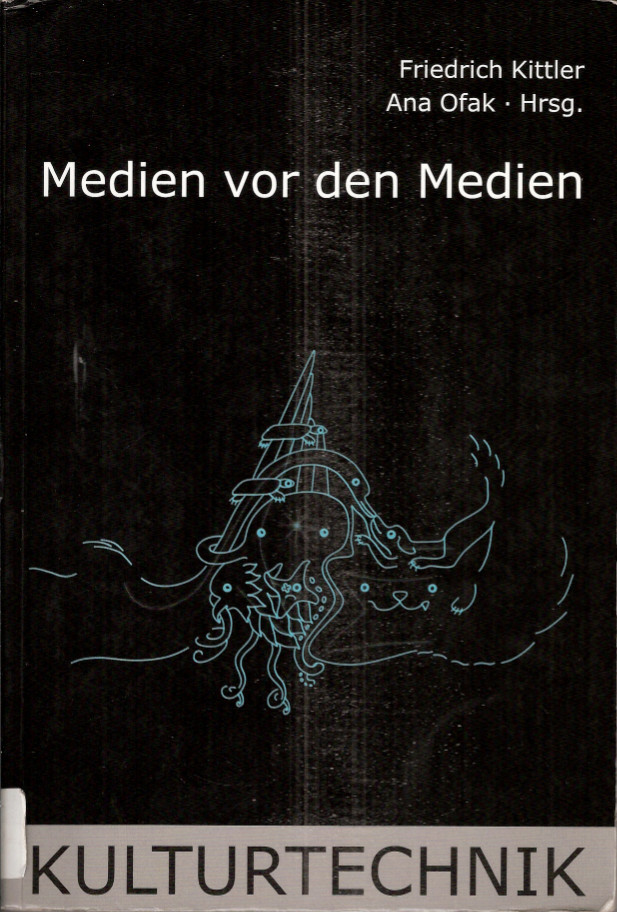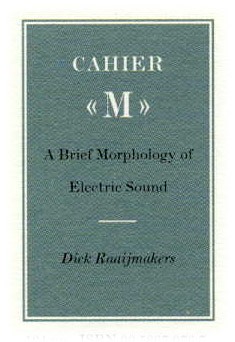Friedrich Kittler, Ana Ofak (eds.): Medien vor den Medien (2007) [German]
Filed under book | Tags: · architecture, cultural techniques, image, literature, media, media theory, mediality, music, music history, philosophy, sound, time

“Das Dazwischen (to metaxy) macht das Sehen und Hören, die Erkenntnis und die Liebe erst möglich – das überliefern uns Texte der Antike. Die Medien prägen so unser Wissen und verstören unsere Sinne seit jeher. In der deutschen Medienwissenschaft ist es fast zur Selbstverständlichkeit geworden, nur heutige oder doch neuzeitliche Medien zu erforschen. Nun geht aber schon der Begriff “Medium” auf die griechische Antike zurück. Eben diesem Sachverhalt sucht der Band Medien vor den Medien gerecht zu werden. Vom Feuertelegraphen zur Ontologie, vom Marienglas zur sakralen Lichtarchitektur und immer wieder vom Ton zum Bild. Da die Medien der Antike zunächst zur Sprache kommen, wird es möglich, Brücken zu anderen Wissenschaftskulturen und in jene Neuzeit zu schlagen, die unseren kurrenten Begriff physikalischer und technischer Medien prägt. Das Buch richtet sich an Philosophen, Kunst-, Kultur- und Medienwissenschaftler.”
Publisher Fink, Munich, 2007
Kulturtechnik series
ISBN 3770542843, 9783770542840
282 pages
via adorno77
Cultural techniques at Monoskop wiki
PDF (53 MB, no OCR, updated on 2020-4-20)
Comment (0)Dick Raaijmakers: Cahier-M: A Brief Morphology of Electric Sound (2000)
Filed under book | Tags: · acoustics, architecture, electronic music, music, music theory, sound

Cahier-M is about the morphology of electric sound. This inherently single-layered type of sound is discussed in the light of ‘neo-plastic’ music as suggested by the painter Piet Mondriaan in the 1920’s. He advocated a kind of music that consisted of single-layered, ‘single-colour’ electric sounds.
Furthermore, Cahier-M devotes ample attention to the morphological relationship between the typically uniform nature of electric sound and the multi-layered sound structures used by post-WWII serial composers. The discussion of this subject also covers layering (photo)graphic images as practised by the French physiologist E.J. Marey at the end of the 19th century, flipping monadic sound aggregates as practised by Karel Goeyvaerts since 1952, the application of so-called ‘horizontal arpeggios’ by Pierre Boulez around 1980, and the introduction of ‘liquid forms’ in contemporary architecture.
These aspects are illustrated based on a still valid morphological analysis of sound conducted by the author between 1963 and 1967.
Cahier-M comprises four chapters: ‘Invented Sound’, ‘Diagonal Sound’, ‘Composed Sound’ and ‘Spatial Sound’.
Publisher Leuven University Press, 2000
Volume 3 of Collected Writings of the Orpheus Institute
ISBN 9058670767
123 pages
See also Raaijmakers’ Method (1985) and The Destructive Character (1992).
Comment (0)Allan Janik, Stephen Toulmin: Wittgenstein’s Vienna (1973)
Filed under book | Tags: · architecture, art, city, history, language, music, philosophy, vienna, vienna circle

“The central figure in this portrait of a crumbling society giving birth to the modern world without realizing it was Wittgenstein, the brilliant and gifted young thinker whose great book remains the key to modern thought and who went on to influence a whole generation of English thinkers, artists and scientists.
As a portrait of a man, this book is superbly realized. It is even better as a portrait of the age and milieu in which our modern ideas were born–not only in philosophy, but in art, music, literature, architecture, design and style.”
Publisher Simon and Schuster, New York, 1973
A Touchstone Book
ISBN 0671217259, 9780671217259
314 pages
Review: Barry Seldes (H-Net, 1996).
Wittgenstein’s Vienna (English, 1973)
La Viena de Wittgenstein (Spanish, trans. Ignacio Gomez de Liaño, 1998; removed on 2017-10-3 upon request of publishre)

